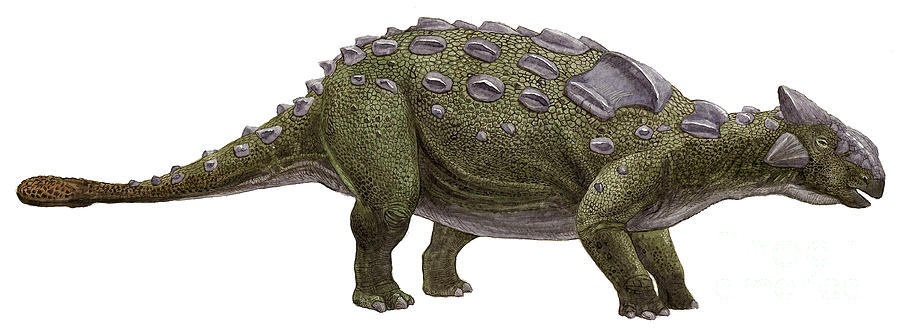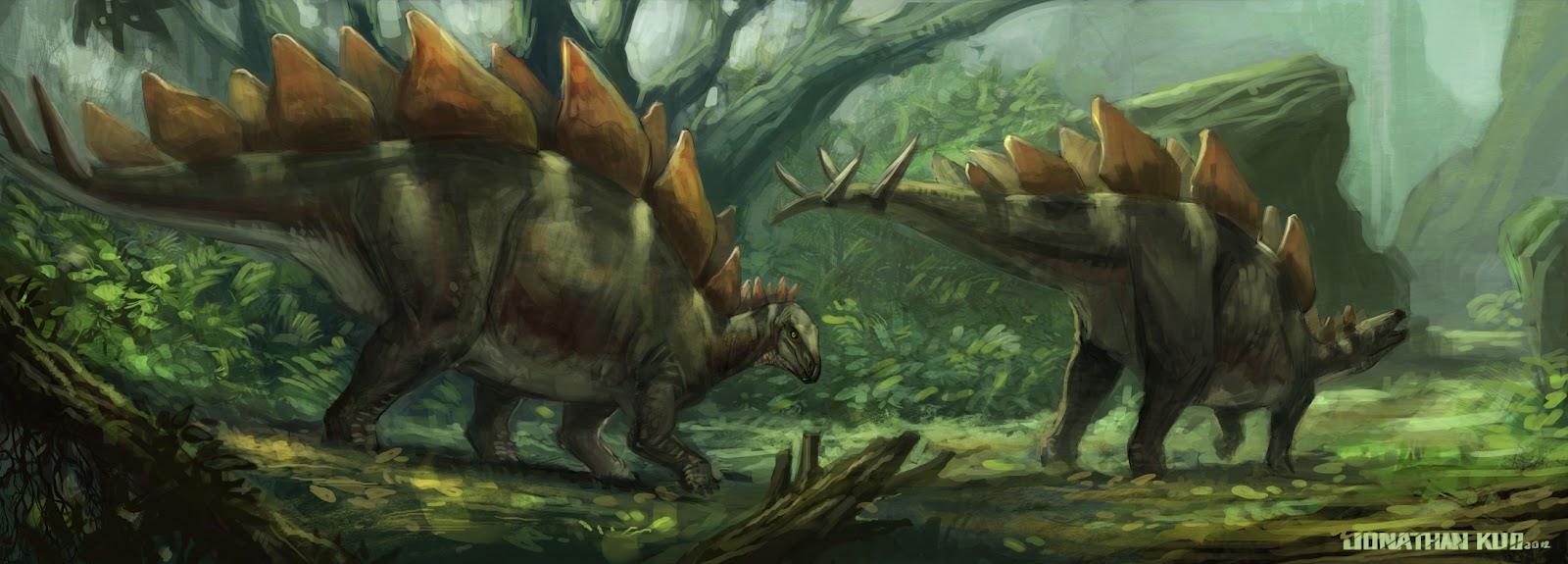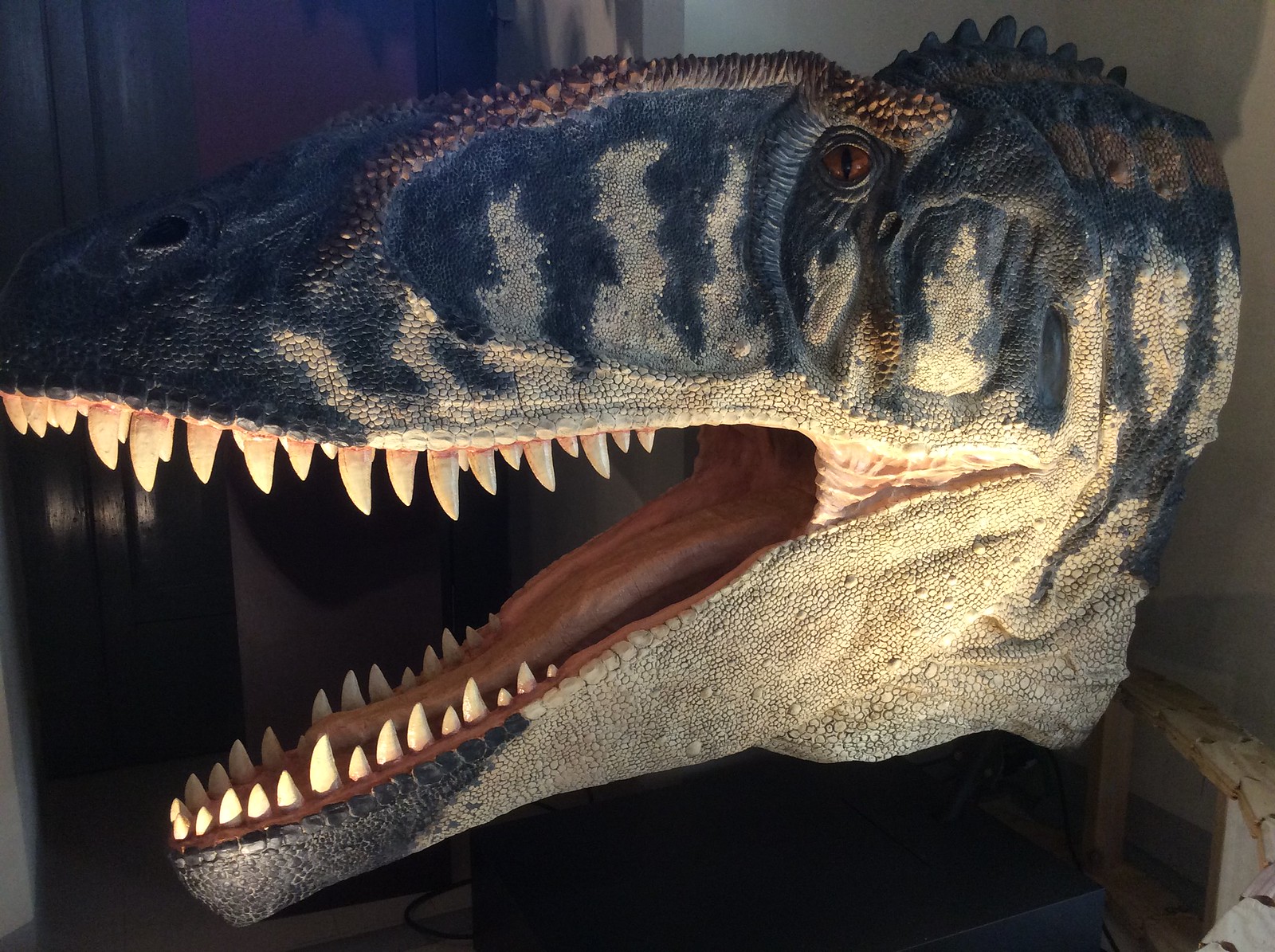Post by Carcharodon on Apr 20, 2014 2:49:08 GMT 5
Ankylosaurus magniventris
Ankylosaurus ("fused lizard") is a genus of ankylosaurid dinosaur, containing one species, A. magniventris. Fossils of Ankylosaurus are found in geologic formations dating to the very end of the Cretaceous Period (between about 66.5–66 Ma ago) in western North America. Although a complete skeleton has not been discovered and several other dinosaurs are represented by more extensive fossil material, Ankylosaurus is often considered the archetypal armored dinosaur. Other ankylosaurids shared its well-known features—the heavily armored body and massive bony tail club—but Ankylosaurus was the largest known member of the family. Ankylosaurus was about 6-7 meters (20-23 feet) in length, and a probable mass of 2 to 3 tonnes, with a skull 64.5 cm (25.4 in) long and 74.5 cm (29.3 in) wide. Its body shape was low-slung and wide. It was quadrupedal, with the hind limbs longer than the forelimbs. The skull was low and triangular in shape, wider than it was long. Like other ankylosaurs, Ankylosaurus was herbivorous, with small, leaf-shaped teeth suitable for cropping vegetation. Ankylosaurus did not share the grinding tooth batteries of the contemporaneous ceratopsid and hadrosaurid dinosaurs, indicating that very little chewing occurred. Bones in the skull and other parts of the body were fused, increasing their strength. The most obvious feature of Ankylosaurus is its armor, consisting of massive knobs and plates of bone, known as osteoderms or scutes, embedded in the skin. Osteoderms are also found in the skin of crocodiles, armadillos and some lizards. The bone was probably overlain by a tough, horny layer of keratin. These osteoderms ranged greatly in size, from wide, flat plates to small, round nodules The famous tail club of Ankylosaurus was also composed of several large osteoderms, which were fused to the last few tail vertebrae. It was heavy and supported by the last seven tail vertebrae, which interlocked to form a stiff rod at the base of the club. Thick tendons have been preserved, which attached to these vertebrae. These tendons were partially ossified (or bony) and were not very elastic, allowing great force to be transmitted to the end of the tail when it was swung. It seems to have been an active defensive weapon, capable of producing enough of a devastating impact to break the bones of a threat like a predator.

Stegosaurus stenops
Stegosaurus (meaning "roof lizard" in reference to its bony plates) is a genus of armored stegosaurid dinosaur. They lived during the Late Jurassic period (Kimmeridgian to early Tithonian), some 155 to 150 million years ago in what is now western North America. Due to its distinctive tail spikes and plates, Stegosaurus is one of the most recognizable dinosaurs. A large, heavily built, herbivorous quadruped, Stegosaurus had a distinctive and unusual posture, with a heavily rounded back, short forelimbs, head held low to the ground and a stiffened tail held high in the air. Its array of plates and spikes has been the subject of much speculation. The spikes were most likely used for defense, while the plates have also been proposed as a defensive mechanism, as well as having display and thermoregulatory functions. Stegosaurus had a relatively low brain-to-body mass ratio. It had a short neck and small head, meaning it most likely ate low-lying bushes and shrubs. The best known species, Stegosaurus stenops, may have been up to 7 metres (23 ft) in length. The most recognizable features of Stegosaurus are its dermal plates, which consisted of 17 separate flat plates. These were highly modified osteoderms (bony-cored scales), similar to those seen in crocodiles and many lizards today. They were not directly attached to the animal's skeleton, instead arising from the skin. The largest plates were found over the animal's hips and measured 60 centimeters (2 ft) wide and 60 centimeters tall.

Ankylosaurus ("fused lizard") is a genus of ankylosaurid dinosaur, containing one species, A. magniventris. Fossils of Ankylosaurus are found in geologic formations dating to the very end of the Cretaceous Period (between about 66.5–66 Ma ago) in western North America. Although a complete skeleton has not been discovered and several other dinosaurs are represented by more extensive fossil material, Ankylosaurus is often considered the archetypal armored dinosaur. Other ankylosaurids shared its well-known features—the heavily armored body and massive bony tail club—but Ankylosaurus was the largest known member of the family. Ankylosaurus was about 6-7 meters (20-23 feet) in length, and a probable mass of 2 to 3 tonnes, with a skull 64.5 cm (25.4 in) long and 74.5 cm (29.3 in) wide. Its body shape was low-slung and wide. It was quadrupedal, with the hind limbs longer than the forelimbs. The skull was low and triangular in shape, wider than it was long. Like other ankylosaurs, Ankylosaurus was herbivorous, with small, leaf-shaped teeth suitable for cropping vegetation. Ankylosaurus did not share the grinding tooth batteries of the contemporaneous ceratopsid and hadrosaurid dinosaurs, indicating that very little chewing occurred. Bones in the skull and other parts of the body were fused, increasing their strength. The most obvious feature of Ankylosaurus is its armor, consisting of massive knobs and plates of bone, known as osteoderms or scutes, embedded in the skin. Osteoderms are also found in the skin of crocodiles, armadillos and some lizards. The bone was probably overlain by a tough, horny layer of keratin. These osteoderms ranged greatly in size, from wide, flat plates to small, round nodules The famous tail club of Ankylosaurus was also composed of several large osteoderms, which were fused to the last few tail vertebrae. It was heavy and supported by the last seven tail vertebrae, which interlocked to form a stiff rod at the base of the club. Thick tendons have been preserved, which attached to these vertebrae. These tendons were partially ossified (or bony) and were not very elastic, allowing great force to be transmitted to the end of the tail when it was swung. It seems to have been an active defensive weapon, capable of producing enough of a devastating impact to break the bones of a threat like a predator.

Stegosaurus stenops
Stegosaurus (meaning "roof lizard" in reference to its bony plates) is a genus of armored stegosaurid dinosaur. They lived during the Late Jurassic period (Kimmeridgian to early Tithonian), some 155 to 150 million years ago in what is now western North America. Due to its distinctive tail spikes and plates, Stegosaurus is one of the most recognizable dinosaurs. A large, heavily built, herbivorous quadruped, Stegosaurus had a distinctive and unusual posture, with a heavily rounded back, short forelimbs, head held low to the ground and a stiffened tail held high in the air. Its array of plates and spikes has been the subject of much speculation. The spikes were most likely used for defense, while the plates have also been proposed as a defensive mechanism, as well as having display and thermoregulatory functions. Stegosaurus had a relatively low brain-to-body mass ratio. It had a short neck and small head, meaning it most likely ate low-lying bushes and shrubs. The best known species, Stegosaurus stenops, may have been up to 7 metres (23 ft) in length. The most recognizable features of Stegosaurus are its dermal plates, which consisted of 17 separate flat plates. These were highly modified osteoderms (bony-cored scales), similar to those seen in crocodiles and many lizards today. They were not directly attached to the animal's skeleton, instead arising from the skin. The largest plates were found over the animal's hips and measured 60 centimeters (2 ft) wide and 60 centimeters tall.













